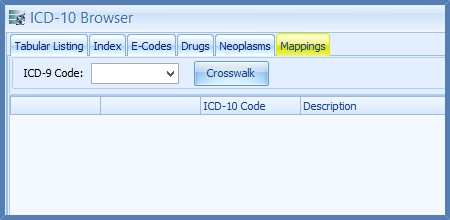
One of the most exciting features of the ICD-10 Browser is the ability to help you find which ICD-10 code(s) correspond to an ICD-9 code. ICD-9 and ICD-10 were created very differently from the ground up, so there will be many times when a single ICD-9 code will not directly translate to a single ICD-10 code
The “Mappings” tab allows you to enter an ICD-9 code and “Crosswalk” it to ICD-10. You can click the drop-down arrow and choose one of your existing Diagnosis Codes or directly enter (type) any ICD-9 code and click Crosswalk. The results will show you the ICD-10 code(s) that correspond to your ICD-9 code. Some ICD-9 codes will have a simple one-to-one mapping to an ICD-10 code, while other ICD-9 codes will have more complex ICD-10 mappings. Some ICD-9 codes have no mapping whatsoever to any ICD-10 code. Whatever your results, always pay close attention to the “Approximate” flag on the right hand side of each displayed ICD-10 code. Even when the mapping is a very simple one-to-one result, if the ICD-10 code is approximate you still may need a more specific ICD-10 code. The only result that you can know is absolutely directly mapped is when the result is one-to-one and the Approximate flag is unchecked.
